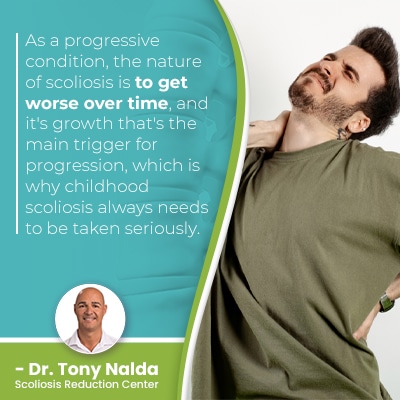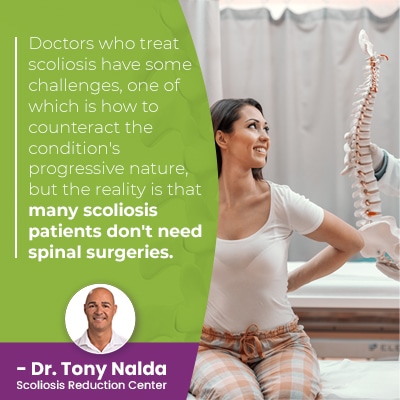Columbia SC Scoliosis Treatment: Non-Surgical Solutions

Scoliosis treatment is important because as a progressive condition, virtually all conditions are going to get worse at some point. Certain types of treatment offer benefits that others don't, so it's important for patients to be aware of all treatment options available to them, and that can involve having to travel to reach a certain treatment provider.
Columbia SC scoliosis treatment is within reach of Orlando, Florida's Scoliosis Reduction Center® with a 3.5-hour flight or a 6.5-hour drive. The Center is an innovative leader in non-surgical scoliosis treatment solutions, and many travel great distances to benefit from its integrative treatment approach.
Non-surgical treatment solutions for scoliosis can help preserve the spine's natural strength and function so comes with a number of benefits.
Table of Contents
How Does Scoliosis Affect the Spine?
As a structural spinal condition, scoliosis involves a structural abnormality within the spine itself, and these are vertebrae that are unnaturally tilted and twisted, causing the spine to develop an unhealthy sideways bending curvature.
The spine's healthy curves make it stronger, more flexible, and better able to handle mechanical stress, and the development of a single unhealthy curve can disrupt the biomechanics of the entire spine.
Scoliosis causes the spine to bend and twist unnaturally, and this exposes it to uneven forces, and those uneven forces affect the body in a number of different ways.
The Spine and Progression
 As a progressive condition, the nature of scoliosis is to get worse over time, and it's growth that's the main trigger for progression, which is why childhood scoliosis always needs to be taken seriously.
As a progressive condition, the nature of scoliosis is to get worse over time, and it's growth that's the main trigger for progression, which is why childhood scoliosis always needs to be taken seriously.
Scoliosis getting worse means the size of the unnatural spinal curve is increasing, as are the condition's uneven forces, and their effects.
As the spine bends and twists more severely, it becomes increasingly rigid, and this can make the spine less responsive to treatment and increasingly painful.
Scoliosis becomes a compressive condition once skeletal maturity has been reached, and it's compression (uneven pressure) of the spine and its surroundings that causes the majority of condition-related pain.
So for adults, progression is likely to increase back pain, muscle pain, and pain that radiates into the extremities due to nerve compression, and in children, the main effect of progression involves increasing postural changes.
How Does Scoliosis Affect the Muscles?
Scoliosis treatment can't just focus on the spine because it's not just the spine that's responsible for maintaining its natural curves and alignment, but also the spine's surrounding muscles.
The muscles that surround the spine provide it with support and stability, and the uneven forces of scoliosis don't just affect the spine, but also its surrounding muscles.
Scoliosis is associated with muscular imbalance as an unnaturally-curved spine can pull the muscles that surround the spine in different directions; the muscles on one side can become stretched and sore from overuse while muscles on the opposite side can become weak from underuse.
A muscular imbalance is also going to get worse alongside compression, and this can involve painful muscle spasms and muscle weakness.
A key focus of non-surgical scoliosis treatment is on restoring core muscle strength and balance.
How Does Scoliosis Affect the Nerves?
Scoliosis affects the entire body, but particularly the spine and its immediate surroundings, which includes the 31 pairs of spinal nerves that make up the spinal cord.
When the spine is curved and rotates unnaturally, the nerves within are being exposed to uneven pressure, and this can cause the nerves to become irritated, inflamed, compressed, and/or impinged.
Nerve compression can have a number of serious effects that include pain and strange sensations such as numbness, tingling, and weakness.
Nerve-related back pain can be severe, and remember, as nerves are like branches of a tree fanning off in different directions, nerve pain can be felt far from its site of origin.
For example, in cases of lumbar scoliosis, sciatic nerve pain is a common complication because the sciatic nerve starts in the lower back, and if the lower spine's unnatural bend and twist is pressing on the sciatic nerve, discomfort can be felt anywhere along the nerve's extensive pathway: from the lower back to the feet.
The Scoliosis Reduction Center's Non-Surgical Approach
There are two main ways to treat scoliosis: with and without surgery.
Traditional scoliosis treatment commonly funnels patients towards spinal fusion surgery, and the procedure is costly, invasive, and risky.
In addition, spinal fusion is only treating the spine, but what about the spine's surroundings? Because we know that scoliosis doesn't just affect the spine, but also its surrounding muscles and nerves, and the entire body.
One of the many benefits of non-surgical treatment is that it's integrative so patients benefit from what multiple different types of treatments have to offer, treatment plans can be easily customized, and conditions can be impacted on multiple levels.
All facets of conservative treatment are scoliosis-specific and include chiropractic care, physical therapy, corrective bracing, and rehabilitation.
As a scoliosis chiropractor, Dr. Tony knows the spine and he knows scoliosis, and being trained in multiple treatment modalities means treatment plans can be easily adjusted and apportioned accordingly based on how a patient's spine is responding to growth and treatment.
So traveling to Orlando, Florida's Scoliosis Reduction Center® from Columbia SC can be well worth the 3.5-hour flight or 6.5-hour drive to access so many different types of treatment under one roof.
Once a patient of the Center, little more travel is needed, and Florida boasts some major tourist attractions that can make the trip even more worthwhile.
Reducing the Curve
Reducing the size of the curve is the main goal of a conservative approach; this is addressing the condition's underlying structural nature.
Curvature reductions are worked towards through a series of chiropractic techniques and manual adjustments that can help reposition the curve's most-tilted vertebrae: improving the spine's alignment and restoring as much of its healthy curves as possible.
But this is just addressing the structural issues within the spine, but what about how the condition has affected the spine's surroundings? This is where the big difference between traditional surgical treatment and a whole-patient centered conservative approach is highlighted.
Another key facet of treatment is on addressing how scoliosis affects its surrounding muscles.
Physical Therapy
In cases where a lot of progression has already occurred, physical therapy and scoliosis exercises can be necessary to increase the spine's flexibility and make it ready for treatment.
Physical therapy and scoliosis exercise is also applied to increase the strength of the spine's surrounding muscles so they can optimally support and stabilize the structural changes achieved through chiropractic care; you can see how these different treatment disciplines work together.
Physical therapy can also restore muscle balance, improve posture, and activate certain areas of the brain for improved brain-body position and a healthier body positioning.
Physical therapy has to be scoliosis-specific and when integrated into a treatment plan with other corrective treatments, it can be a valuable facet of treatment.
Scoliosis Bracing
 Scoliosis bracing is commonly used when treating childhood scoliosis because as a child's spine is still growing, it's more malleable and responsive to corrective bracing.
Scoliosis bracing is commonly used when treating childhood scoliosis because as a child's spine is still growing, it's more malleable and responsive to corrective bracing.
Corrective bracing, like the ScoliBrace, can help augment corrective treatment results by pushing the spine into a corrective position.
For adults, bracing is more about short-term pain management and increasing the spine's stability than it is about correction.
Rehabilitation
Rehabilitation can involve continued chiropractic care and the prescription of a series of custom-designed scoliosis exercises that patients can perform from home to continue healing and stabilizing the spine.
Doctors who treat scoliosis have some challenges, one of which is how to counteract the condition's progressive nature, but the reality is that many scoliosis patients don't need spinal surgeries.
Conclusion
Columbia sc scoliosis treatment can include what Dr. Tony and the Scoliosis Reduction Center® has to offer: a proactive treatment plan that combines the power of multiple different types of scoliosis treatment for the best results.
A 3.5-hour flight from Columbia, South Carolina to Orlando, Florida, or a 6.5-hour car drive, can mean accessing leading non-surgical scoliosis treatment that many patients have to travel farther to access.
Most cases of scoliosis are responsive to non-surgical treatment, particularly when early detection and intervention have been achieved; there are never treatment guarantees, but the earlier treatment is started, and the milder a patient's scoliosis is when treatment is started, the more likely treatment success is going to be.
The best way to prevent scoliosis from progressing and minimize its effects is to treat it proactively, so for those interested in what a leading non-surgical scoliosis treatment provider can offer should reach out for more information.
Dr. Tony Nalda
DOCTOR OF CHIROPRACTIC
After receiving an undergraduate degree in psychology and his Doctorate of Chiropractic from Life University, Dr. Nalda settled in Celebration, Florida and proceeded to build one of Central Florida’s most successful chiropractic clinics.
His experience with patients suffering from scoliosis, and the confusion and frustration they faced, led him to seek a specialty in scoliosis care. In 2006 he completed his Intensive Care Certification from CLEAR Institute, a leading scoliosis educational and certification center.
About Dr. Tony Nalda
 Ready to explore scoliosis treatment? Contact Us Now
Ready to explore scoliosis treatment? Contact Us Now





